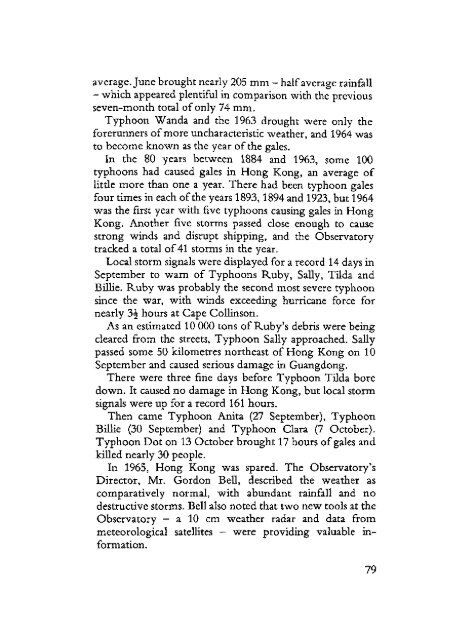Royal - HKU Libraries - The University of Hong Kong
Royal - HKU Libraries - The University of Hong Kong
Royal - HKU Libraries - The University of Hong Kong
Create successful ePaper yourself
Turn your PDF publications into a flip-book with our unique Google optimized e-Paper software.
average. June brought nearly 205 mm - half average rainfall- which appeared plentiful in comparison with the previousseven-month total <strong>of</strong> only 74 mm.Typhoon Wanda and the 1963 drought were only theforerunners <strong>of</strong> more uncharacteristic weather, and 1964 wasto become known as the year <strong>of</strong> the gales.In the 80 years between 1884 and 1963, some 100typhoons had caused gales in <strong>Hong</strong> <strong>Kong</strong>, an average <strong>of</strong>little more than one a year. <strong>The</strong>re had been typhoon galesfour times in each <strong>of</strong> the years 1893,1894 and 1923, but 1964was the first year with five typhoons causing gales in <strong>Hong</strong><strong>Kong</strong>. Another five storms passed close enough to causestrong winds and disrupt shipping, and the Observatorytracked a total <strong>of</strong> 41 storms in the year.Local storm signals were displayed for a record 14 days inSeptember to warn <strong>of</strong> Typhoons Ruby, Sally, Tilda andBillie. Ruby was probably the second most severe typhoonsince the war, with winds exceeding hurricane force fornearly 3J hours at Cape Collinson.As an estimated 10 000 tons <strong>of</strong> Ruby's debris were beingcleared from the streets, Typhoon Sally approached. Sallypassed some 50 kilometres northeast <strong>of</strong> <strong>Hong</strong> <strong>Kong</strong> on 10September and caused serious damage in Guangdong.<strong>The</strong>re were three fine days before Typhoon Tilda boredown. It caused no damage in <strong>Hong</strong> <strong>Kong</strong>, but local stormsignals were up for a record 161 hours.<strong>The</strong>n came Typhoon Anita (27 September), TyphoonBillie (30 September) and Typhoon Clara (7 October).Typhoon Dot on 13 October brought 17 hours <strong>of</strong> gales andkilled nearly 30 people.In 1965, <strong>Hong</strong> <strong>Kong</strong> was spared. <strong>The</strong> Observatory'sDirector, Mr. Gordon Bell, described the weather ascomparatively normal, with abundant rainfall and nodestructive storms. Bell also noted that two new tools at theObservatory - a 10 cm weather radar and data frommeteorological satellites - were providing valuable information.79
















